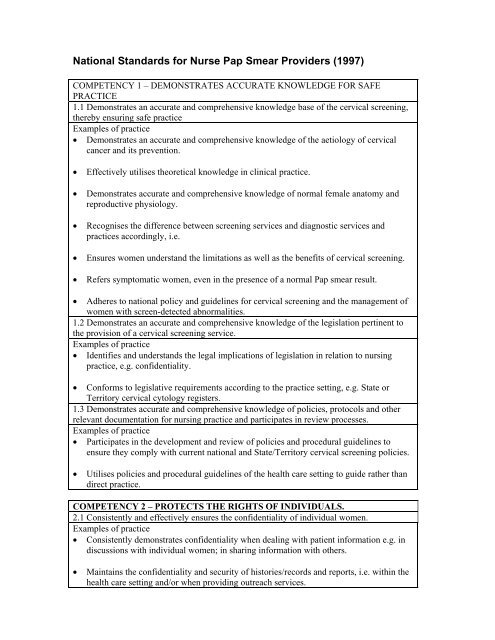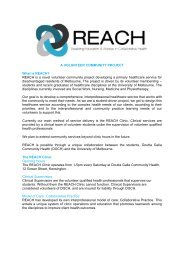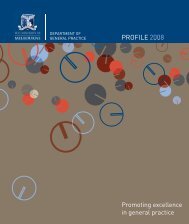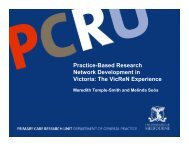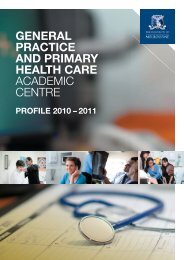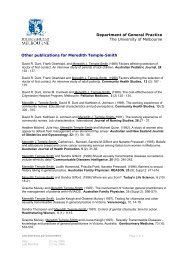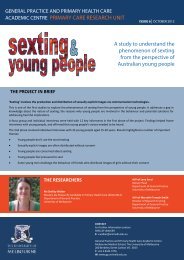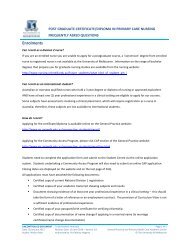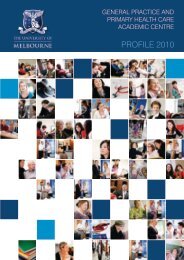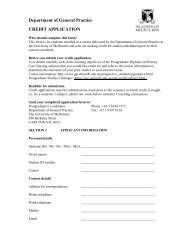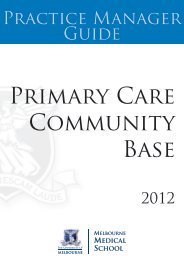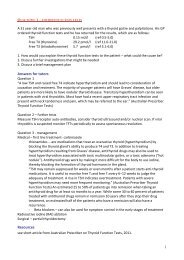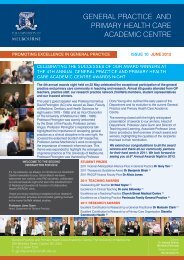National Standards for Nurse Pap Smear Providers (1997)
National Standards for Nurse Pap Smear Providers (1997)
National Standards for Nurse Pap Smear Providers (1997)
You also want an ePaper? Increase the reach of your titles
YUMPU automatically turns print PDFs into web optimized ePapers that Google loves.
<strong>National</strong> <strong>Standards</strong> <strong>for</strong> <strong>Nurse</strong> <strong>Pap</strong> <strong>Smear</strong> <strong>Providers</strong> (<strong>1997</strong>)<br />
COMPETENCY 1 – DEMONSTRATES ACCURATE KNOWLEDGE FOR SAFE<br />
PRACTICE<br />
1.1 Demonstrates an accurate and comprehensive knowledge base of the cervical screening,<br />
thereby ensuring safe practice<br />
Examples of practice<br />
• Demonstrates an accurate and comprehensive knowledge of the aetiology of cervical<br />
cancer and its prevention.<br />
• Effectively utilises theoretical knowledge in clinical practice.<br />
• Demonstrates accurate and comprehensive knowledge of normal female anatomy and<br />
reproductive physiology.<br />
• Recognises the difference between screening services and diagnostic services and<br />
practices accordingly, i.e.<br />
• Ensures women understand the limitations as well as the benefits of cervical screening.<br />
• Refers symptomatic women, even in the presence of a normal <strong>Pap</strong> smear result.<br />
• Adheres to national policy and guidelines <strong>for</strong> cervical screening and the management of<br />
women with screen-detected abnormalities.<br />
1.2 Demonstrates an accurate and comprehensive knowledge of the legislation pertinent to<br />
the provision of a cervical screening service.<br />
Examples of practice<br />
• Identifies and understands the legal implications of legislation in relation to nursing<br />
practice, e.g. confidentiality.<br />
• Con<strong>for</strong>ms to legislative requirements according to the practice setting, e.g. State or<br />
Territory cervical cytology registers.<br />
1.3 Demonstrates accurate and comprehensive knowledge of policies, protocols and other<br />
relevant documentation <strong>for</strong> nursing practice and participates in review processes.<br />
Examples of practice<br />
• Participates in the development and review of policies and procedural guidelines to<br />
ensure they comply with current national and State/Territory cervical screening policies.<br />
• Utilises policies and procedural guidelines of the health care setting to guide rather than<br />
direct practice.<br />
COMPETENCY 2 – PROTECTS THE RIGHTS OF INDIVIDUALS.<br />
2.1 Consistently and effectively ensures the confidentiality of individual women.<br />
Examples of practice<br />
• Consistently demonstrates confidentiality when dealing with patient in<strong>for</strong>mation e.g. in<br />
discussions with individual women; in sharing in<strong>for</strong>mation with others.<br />
• Maintains the confidentiality and security of histories/records and reports, i.e. within the<br />
health care setting and/or when providing outreach services.
2.2 Consistently and effectively ensuring the rights of women to make in<strong>for</strong>med decisions<br />
regarding their care.<br />
Examples of practice<br />
• Ensures women are in<strong>for</strong>med and understand the benefits and limitations of cervical<br />
screening, including new technologies.<br />
• Recognises the rights of women to full and comprehensive in<strong>for</strong>mation regarding their<br />
care.<br />
Respects the rights of women to be accompanied by a support person of her choice.<br />
COMPETENCY 3 – RECOGNISES OWN ABILITY AND LEVEL OF<br />
PROFESSIONAL COMPETENCE.<br />
3.1 Assesses own abilities independently, comprehensively and practises within these limits<br />
and scopes of practice.<br />
Examples of practice<br />
• Functions independently, and interdependently with others using advanced practice<br />
knowledge and skills.<br />
• Recognises the boundaries of own nursing practice and refers women accordingly.<br />
• Regularly reflects on own standard of practice and sets appropriate per<strong>for</strong>mance<br />
objectives.<br />
3.2 Engages in activities to enhance own level of practice.<br />
Examples of practice<br />
• Seeks to maintain currency of practice regarding the provision of a cervical screening<br />
service, e.g. participates in professional development activities, and seeks peer review.<br />
• Critically evaluates research findings utilising those which have relevance to own<br />
practice setting.<br />
• Ensures the integration of new knowledge regarding cervical screening and management<br />
of women with screen detected abnormalities into own practice.<br />
• Actively participates in quality assurance/improvement activities and uses feedback to<br />
improve clinical per<strong>for</strong>mance, e.g. cytology laboratory <strong>Pap</strong> smear statistics.
3.3 Consistently and effectively integrates cervical screening provision within the broader<br />
context of issues affecting women’s health.<br />
Examples of practice<br />
• Demonstrates accurate and comprehensive knowledge of issues affecting women’s<br />
health, referring appropriately when outside own level of expertise, e.g.<br />
women’s reproductive physiology<br />
breast screening<br />
sexually transmitted infections<br />
sexuality<br />
sexual or emotional abuse<br />
family concerns<br />
social issues, etc.<br />
• Demonstrates ability to listen to and respond effectively to issues and concerns effecting<br />
individual women.<br />
COMPETENCY 4 – ACTS TO ENHANCE THE DIGNITY AND INTEGRITY OF<br />
WOMEN.<br />
4.1 Employs effective communication and interpersonal skills to meet the needs of<br />
individual women.<br />
Examples of practice<br />
• Actively listens to needs and concerns of individual women and responds appropriately.<br />
• Provides the opportunity <strong>for</strong> women to express their opinions and be involved in all<br />
aspects of their care.<br />
• Facilitates individual women’s understanding of her conditions/issues, e.g. uses<br />
appropriate language, provides written material.<br />
• Provides the opportunity <strong>for</strong> women to withdraw from the procedure without her care<br />
being compromised.<br />
4.2 Respects the values, cultural and spiritual beliefs of individual women.<br />
Examples of practice<br />
• Demonstrates knowledge and respect of others’ beliefs and social contexts.<br />
• Delivers nursing care <strong>for</strong> the individual woman without prejudice or judgement e.g.<br />
speaks in non-judgemental terms; respects the right of others to their culture, religion or<br />
values; responds appropriately to women with a physical or intellectual disability.<br />
• Endeavours to provide a female trained interpreter, either in person or by telephone,<br />
appropriate <strong>for</strong> the woman’s individual needs.
4.3 Consistently and effectively provides accurate and comprehensive in<strong>for</strong>mation to ensure<br />
women are fully in<strong>for</strong>med regarding cervical screening.<br />
Examples of practice<br />
• Communicates effectively to ensure women are in<strong>for</strong>med about all aspects of cervical<br />
screening, e.g. the limitations of <strong>Pap</strong> smears, including their accuracy; the differences<br />
between a screening and diagnostic service.<br />
• Enhances the education and understanding of women with appropriate use of resources, e.g.<br />
using models, audio visual and/or written material/diagrams.<br />
• Provide the women with the opportunity to make in<strong>for</strong>med decisions, e.g. participation on<br />
cytology registers.<br />
COMPETENCY 5 – MAINTAINS A PHYSICAL AND PSYCHOSOCIAL<br />
ENVIRONMENT WHICH PROMOTES SAFETY, SECURITY AND OPTIMAL<br />
HEALTH CARE.<br />
5.1 Applies strategies to provide effective, efficient cervical screening services.<br />
Examples of practice<br />
• Utilises strategies to provide a cervical screening service <strong>for</strong> women <strong>for</strong> whom other<br />
services are inappropriate or inaccessible, e.g. women in rural and remote areas, women of<br />
non-English speaking background, Aboriginal women etc.<br />
• Employs time management skills to meet the client’s needs.<br />
• Uses feedback from women, both <strong>for</strong>mal and in<strong>for</strong>mal to facilitate on-going quality<br />
improvement.<br />
5.2 Demonstrates sensitivity to women’s health care needs through the provision of cervical<br />
screening services in a safe environment.<br />
Examples of practice<br />
• Consistently and effectively incorporates infection control principles and standards in the<br />
provision of cervical screening services.<br />
• Utilises strategies to ensure that the cervical screening facilities sensitive to women’s needs,<br />
e.g. examination couch and equipment area is clean and well organised, chairs are<br />
positioned to facilitate communication.<br />
5.3 Ensures the women’s physical and psychological com<strong>for</strong>t throughout the Par smear<br />
procedure.<br />
Examples of practice<br />
• Utilises strategies to ensure the women’s privacy is maintained e.g. using screens/blinds;<br />
providing a cover sheet etc.<br />
• Facilitates the active participation of individual women in the <strong>Pap</strong> smear procedure, e.g.<br />
through explanation; pacing the procedure according to the woman’s needs, ensuring the<br />
woman’s com<strong>for</strong>t.<br />
• Uses strategies to accommodate the special needs of women with disabilities using positions<br />
accordingly.<br />
• Responds appropriately to an individual woman’s indication of pain, discom<strong>for</strong>t or distress.
COMPETENCY 6- ACTS TO MAINTAIN THE RIGHTS OF WOMEN TO MAKE<br />
INFORMED DECISIONS<br />
6.1 Ensures the provision of <strong>Pap</strong> <strong>Smear</strong> results are according to the needs of the individual<br />
woman.<br />
Examples of practice<br />
• Discuss the time and methods of notification of <strong>Pap</strong> smear results, to ensure women are<br />
in<strong>for</strong>med and mutually acceptable arrangement is made <strong>for</strong> receipt of results.<br />
• Encourages women to take responsibility <strong>for</strong> obtaining their <strong>Pap</strong> smear result.<br />
• Consistently uses effective communication skills so that women understand the significance<br />
of the <strong>Pap</strong> <strong>Smear</strong> results and follow up procedures.<br />
• Provides the women with the opportunity <strong>for</strong> a copy of the <strong>Pap</strong> <strong>Smear</strong> result to be sent to<br />
her medical practitioner.<br />
6.2 Consistently and effectively ensures women are notified of the <strong>Pap</strong> smear results promptly.<br />
Examples of practice<br />
• Utilises strategies to ensure a <strong>Pap</strong> smear results and recall system is maintained.<br />
• Demonstrates comprehensive knowledge to enable accurate interpretation of <strong>Pap</strong> <strong>Smear</strong><br />
results.<br />
• Uses strategies to make contact with women whose <strong>Pap</strong> smear results are normal within<br />
four weeks of receiving the result.<br />
• Implements strategies to ensure women with abnormal <strong>Pap</strong> <strong>Smear</strong> results are contacted as<br />
soon as possible (maximum of four weeks).<br />
• Ensures appropriate personnel/agencies are in<strong>for</strong>med if the woman is unable to be<br />
contacted, e.g. the cytology laboratory and/or cytology register.<br />
• Maintains accurate documentation of <strong>Pap</strong> <strong>Smear</strong> reports, contact with the woman and<br />
follow-up procedures.
COMPETENCY 7 – INTEGRATES COMPREHENSIVE HEALTH ASSESSMENT AND<br />
INTERPRETIVE SKILLS TO ACHIEVE OPTIMAL CARE FOR WOMEN.<br />
7.1 Obtains a comprehensive and accurate health history assessment and maintains accurate<br />
documentation.<br />
Examples of practice<br />
• Utilises a wide variety of strategies to identify key issues of concern to the woman and<br />
responds sensitively, building trust.<br />
• Utilises a systematic approach to obtain and document a comprehensive health history<br />
including:<br />
First day of last normal menstrual period (LNMP)<br />
Obstetric/gynaecological history<br />
<strong>Pap</strong> smear history<br />
Hormone replacement therapy<br />
Contraceptive history<br />
Vaginal infections etc.<br />
• Documentation is comprehensive and accurate.<br />
7.2 Demonstrates accurate knowledge and expertise in the per<strong>for</strong>ming of the <strong>Pap</strong> smear<br />
procedure to ensure optimum sample of cells with minimal discom<strong>for</strong>t to the woman.<br />
Examples of practice<br />
• Utilises strategies to ensure minimal discom<strong>for</strong>t <strong>for</strong> the woman during the <strong>Pap</strong> smear<br />
procedure e.g. checks bladder is empty, warms speculum, utilises appropriate techniques to<br />
visualise the cervix.<br />
• Utilises correct technique to ensure optimum sample <strong>for</strong> adequate <strong>Pap</strong> smear e.g. recognises<br />
and visualises trans<strong>for</strong>mation zone and squamo-columnar junction; uses appropriate<br />
equipment <strong>for</strong> collection of <strong>Pap</strong> <strong>Smear</strong>; labels, <strong>for</strong>ms and slides etc.<br />
• Consistently and effectively recognises vulval, vaginal and cervical variations.<br />
COMPETENCY 8 – COLLABORATES WITH THE HEALTH CARE TEAM TO<br />
ACHIEVE DESIRED OUTCOMES.<br />
8.1 Establishes accurate knowledge of referral services to facilitate access <strong>for</strong> women.<br />
Examples of practice<br />
• Consistently and effectively utilises available referral systems and networks.<br />
• Consistently demonstrates appropriate referral to meet the needs of individual women and<br />
the required level of care.<br />
• Communicates effectively to ensure the woman is in<strong>for</strong>med and gives permission prior to<br />
referral.
8.2 Establishes and maintains collaborative and consultative relationships with professional<br />
colleagues, in particular medical practitioners.<br />
Examples of practice<br />
• Utilises effective strategies in order to establish a supportive relationship with a medical<br />
practitioner within the local community or area health service <strong>for</strong> referral purposes.<br />
• Recognises differences in cytology reports and the need to clarify differences<br />
With medical practitioner<br />
With appropriate personnel in the cytology laboratory.<br />
• Recognises the boundaries of nursing practice and the need to refer symptomatic women.<br />
• Utilises a variety of strategies to advocate <strong>for</strong> women when the need arises.


